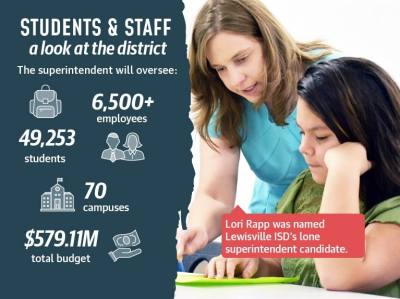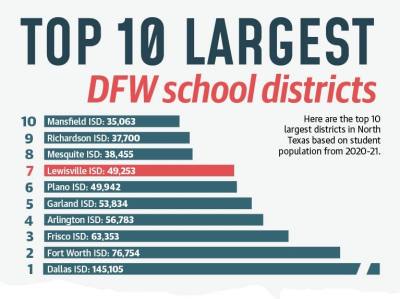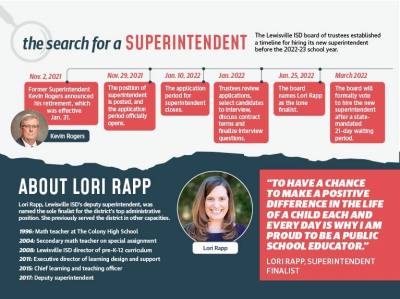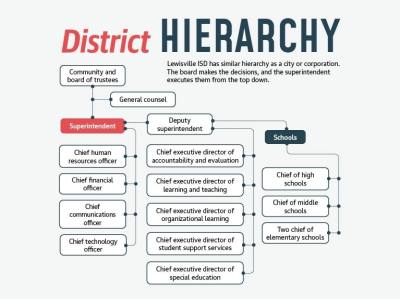The district’s board of trustees named Lori Rapp, the district’s deputy superintendent, the lone finalist for the top position Jan. 25. The board must wait a state-mandated 21 days before it can vote to appoint her superintendent.
The announcement came after the retirement of former Superintendent Kevin Rogers in November and a monthlong search for candidates.
“Dr. Rapp is the ideal choice because she is firmly rooted in all the things that make LISD special, having spent all of her 26-year career in LISD,” board President Tracy Scott Miller said. “Because she’s been a part of where we’ve been, she is uniquely positioned to know where we need to grow and evolve as an organization and has the credibility both internally and externally to lead us through that evolution. It is an exciting time for LISD.”
The new superintendent will have to step into the leadership role for a district grappling with ongoing challenges related to the pandemic along with learning struggles, budget constraints and stalled student growth. Rapp will also learn to work with the board of trustees. The board has three seats up for election this May, which may bring a potential change in leadership.
The entirety of Rapp’s 26-year education career has been at Lewisville ISD. She has served as the district’s chief learning and teaching officer, executive director of learning design and support, director of pre-K-12 curriculum and as a classroom teacher, according to a news release.
Rapp was not available for an interview before press time.
She started out as a math teacher at The Colony High School in 1996. Her first students laid the foundation for her career and instilled a dedication in her to provide an environment where students can thrive, according to the district.
“I believe public education is not only important to our democracy and keeping our communities strong but most importantly invests in the future by investing in all children,” Rapp said in a district news release. “To have a chance to make a positive difference in the life of a child each and every day is why I am proud to be a public school educator.”
Rapp played a pivotal role in developing unique learning pathways for students, including the establishment of LISD’s Programs of Choice, which includes the LISD STEM Academy at the elementary and middle school levels; the Collegiate Academy at The Colony High School; robust world language programs’ and the tuition-based Discovery Academy, according to the release.
Serving the district
Lewisville ISD’s superintendent serves 49,253 students and more than 6,500 employees spread across 70 campuses.
The role of the superintendent is to lead a school district and work with the board of trustees to create board policies that guide the district, said Deborah Cron, who is the GoLead11 Superintendent Program Specialist at Education Service Center Region 11.
“In truth, the buck stops at the superintendent’s desk for all areas of the district,” Cron said. “The single-most important job of the superintendent is to keep students safe and to ensure that they are learning what they need to know to be successful and productive citizens.”The superintendent must always look to put the student needs first, she said. However, the Texas public school finance system is complex, and districts must live within the constraints of that system.
Superintendents must also prioritize what is most important for their district and ensure that these needs are addressed in the budget, Cron said. At LISD, the superintendent oversees a $579.11 million budget.
Despite managing a multimillion-dollar budget, the superintendent must tightly focus on student learning, Cron said.
“There are many, many concerns and needs that seek to grab a superintendent’s attention, and some of those will require the superintendent’s time,’’ she said. “However, the first and foremost work of the superintendent should be on student learning for every child.”
One of the many “hats” a superintendent wears is developing a strong relationship with the board of trustees, Cron said.
The superintendent and the seven-member board of trustees are collectively known as a district’s team of eight, former Richardson ISD trustee Kim Caston said. After her 14-year tenure with the RISD board ended in June, the Texas Education Agency authorized Caston to provide team-of-eight training for districts statewide. “The team of eight is really most effective when the board and superintendent lead and manage the district within their respective roles,” Caston said. The board and superintendent relationship is a critical component to a successful school district, LISD board president Miller said.
“The day-to-day operations of the district are the purview of the superintendent, and the board provides oversight at a high level,” Miller said. “When the team of eight, as it is often called, is functioning well, there is open communication, respectful dialogue, friendly differences of opinions and ultimately a dedication to work through any issue as a team.”
Community responsibility
Outside the boardroom, superintendents must be active in the community and keep lines of communication open, Cron said. He or she also must be a conduit for parents to share concerns and praises.
Communication is a key concern for parent Jennifer Hernandez, who lives in Carrollton and has a 9-year-old daughter in LISD.
The pandemic has exacerbated a communication deficiency in the district, Hernandez said. Prior to the pandemic, she had no issues or concerns with how the district operated.
As a parent, she wants the new superintendent to focus on student safety because she said, “Without that, you don’t have instruction.”
Hiring challenges
The Texas Association of School Administrators offers learning opportunities and advocacy efforts for state superintendents and other school administrators. Kevin Brown, the association’s executive director, said superintendents throughout the state are finding it difficult to satisfy everyone with just about any decision.
“The divisive nature of politics today makes it very difficult to really focus on the children because the adults are taking so much of the oxygen out of the space,” Brown said. “Once you’re deprived of being able to focus on your students [and] focus on serving your community, then you don’t feel like you’re fulfilling your mission. That’s why you’re seeing so many superintendents [resign].
“Our state is losing some extraordinary leaders.”
Cron agreed, noting there are greater numbers of superintendent openings this year. In North Texas, for example, there are superintendent openings in Richardson, Plano, Northwest, Dallas and Fort Worth ISDs as of Feb. 14.
One reason, she noted, is the last of the baby boomer generation is getting ready to retire. The other reason is COVID-19. “This pandemic has resulted in a somewhat divided community—over the wearing of masks, quarantining and vaccines,” she said.
Finding a superintendent
After Rogers announced his retirement as superintendent, the board of trustees created a timeline and candidate profile to find the right person to fill the position.
The goal for the board was to name a sole finalist by February and have the person start in the position by spring or summer this year, according to the district.
“Lewisville ISD is a tremendous school district, and certainly we wanted to find a candidate who would continue the strong traditions found throughout LISD,” Miller said. “It was also important to find someone who had an eye on the future.”
To help with the process, the board turned to the community. Several staff and community feedback sessions were held where parents and staff shared what they would like to see in a superintendent. A survey conducted by the district received 4,180 responses. In that, integrity and transparency were among the top qualities respondents wanted to see.
When looking for superintendent candidates, Hernandez said as a parent she wanted to see a diverse pool of applicants. She wants the district leader to represent the diverse students in the district. At LISD, the student population is 10.7% African American, 29.6% Hispanic and 41.3% white. The remaining 18.5% of students are American Indian, Asian, Pacific Islander, two or more races, according to the district.
Hernandez said she liked how the district held feedback sessions, but she wanted to see more transparency with the search. She wanted to know how many people applied and who the board decided to interview, she said. More than 20 people applied for the position, and the board interviewed five of those applicants, Miller said. Two candidates interviewed in the second round.
Hernandez said she is excited to see Rapp, an internal candidate, be named sole finalist.
“I’m all about internal growth. It is great they are trying to grow from within,” Hernandez said. “It is great to have someone who knows the district.”
William C. Wadsack contributed to this story.
Click here to read the February 2022 e-edition where this story is featured.









